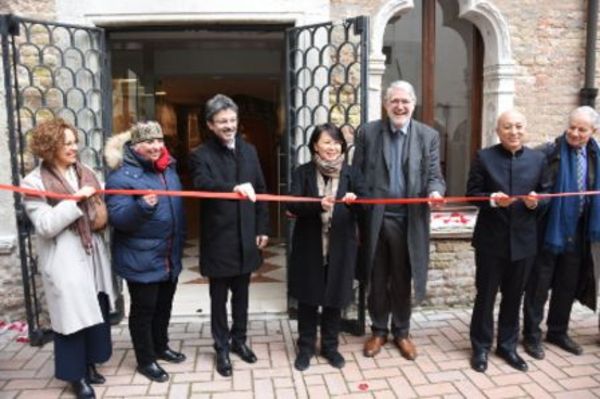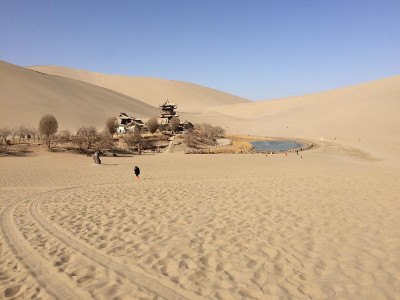For the first time in Italy, in the exhibition space of Ca' Foscari University of Venice, it is possible to "explore" the magnificent painted caves of Dunhuang, in the Western Chinese province of Gansu, between the plateau of Tibet, Mongolia and the Gobi Desert, in the exhibition The Jewel of the Silk Road: Buddhist Art of Dunhuang, which will be held from February 22nd to April 8th 2018 in the main building of the University of Venice.
The exhibition was inaugurated yesterday in the presence of the Rector of Ca’ Foscari University of Venice, Michele Bugliesi, of Wang Xudong 王旭東, Director of the Dunhuang Research Academy, of Tiziana Lippiello, Vice Rector of Ca’ Foscari University of Venice, Sir David Green, Chairman of The Prince’s School of Traditional Arts, London, Wang Yin 王胤, President of Dunhuang Culture Promotion Foundation, and of Paola Mar,the head of tourism for the City of Venice.

The exhibition is the result of a cooperation with the Dunhuang Academy and the Dunhuang Culture Promotion Foundation - co-organisers of the initiative - and was conceived out to strengthen cultural exchange as promoted by the Vice-Provost for International Relations of Ca’ Foscari, Tiziana Lippiello. It aims to build a friendly collaboration along the Silk Road between these two prestigious institutions, and to introduce the Italian public to the Buddhist art of Dunhuang, which is an important historical site with its massive and highly-characteristic Buddhist caves that are listed by the UNESCO as part of the World Heritage. The exhibition shows not only Buddhist art but also wall paintings depicting scenes of Chinese life and society from the 4th to the 14th centuries, as well as daily life in Dunhuang, a crossroads of cultures along the Silk Road. The exhibition is a living and concrete evidence of the trading and cultural exchanges which, over the centuries, have animated the ancient Silk Route, that is currently being promoted and re-proposed by the Chinese government as the "Belt and Road" or "One Belt, One Road", to indicate the privileged route that favoured the diplomatic, commercial and cultural relations of Eurasia.
The complex consists in 735 caves, is 1,680 m long, and is embellished by more than 2,000 statues and 45,000 square metres of wall paintings.
“To host “The Jewel of the Silk Road: Buddhist art of Dunhuang” is a source of pride and an initiative of great importance for Ca' Foscari in the year of its one hundred and fiftieth anniversary” - stated the Rector of Ca' Foscari University of Venice, Michele Bugliesi. “The choice of Venice and Ca' Foscari as venues of the exhibition could not be happier and more appropriate if we consider the many common traits linking the two cities: Venice, pearl of the Adriatic Sea, and Dunhuang, jewel of the Gobi desert; Venice which gave birth to Marco Polo, and Dunhuang which was reached by Marco Polo during his trip to Asia; Venice and Dunhuang, which together contributed to giving a strong impulse to trade, to the spreading of ideas, beliefs, customs, and to the artistic expressions of the peoples encountered by Marco Polo and travellers who preceded and followed him".
The precious art of the caves of Mogao will be revived in Venice thanks to the cooperation between Ca' Foscari University of Venice, Dunhuang Academy and Dunhuang Culture Promotion Foundation, with the aim of presenting to the Italian public the importance of the Silk Road, and of furthering knowledge on the traditional art of China. Professors and students from the Department of Asian and North African Studies worked together in producing the exhibition in Italian language.
The Dunhuang caves
Full of cultural and artistic treasures that makes them acclaimed both in China and worldwide, the Dunhuang Caves are a highly important testimony to the integration process of Chinese culture and other cultures of Eurasia. The works to build them took a millennium, from the fourth to fourteenth centuries, and the caves have preserved both wonderful and precious Buddhist art, and the rich content of historical, cultural and artistic documents. They have also been dubbed "the Buddhist artistic treasure", "the encyclopaedia of the Middle Ages" and "the art gallery in the desert", and are the concrete representation of the spectacular event of a crossroads between different cultures, and a fusion of ethnic groups along the Silk Road.
It is a large Buddhist religious complex of 492 caves-cum-sanctuary dug into the rock that developed starting from the fourth century.
For almost a thousand years, it was added to with niches and caves, masterfully decorated with wall paintings, frescoes and painted stucco sculptures, which cover a total area of over 45,000 square metres. The works were carried out by local craftsmen and commissioned by Buddhist monks, nobles and merchants, as well as by the rulers of the Chinese, Tibetan and Central Asian kingdoms, who followed on from each other in controlling this important cultural and religious economic centre of antiquity. The style of the frescoes and sculptures is predominantly Chinese but also reflects central Asian, Sasanid, Indian and Tibetan influences.
Venice and Dunhuang
Unlike Venice, the water city and "the Pearl of the Adriatic", Dunhuang, on the corridor of Hexi, is an oasis surrounded by high mountains, sand and the Gobi Desert. Compared to Venice which has the symbol of water and which thrived on maritime trade, Dunhuang is one of the main centres of the Silk Road, and vaunts the somewhat different backdrop of sand. Thanks to the initiative of the New Silk Road, today the ‘water capital’ and the ‘desert city’ meet again through the cooperation between the Dunhuang Research Academy and Ca' Foscari University of Venice.
The exhibition
Through the wall paintings, the works of art and the cave reproductions, Dunhuang's past and present are depicted from such various points of view as history, geography, art and crafts, religions, literature, economics, and science. The exhibition aims to present the ancient culture of Dunhuang that accumulated over time through the allure of reproducing the places that will be "visited at a distance".
The modernity of Dunhuang's culture is expressed through an in-depth analysis on various levels which, from its cultural background, take visitors through its process of formation, the artistic content of the caves, the traffic along the Silk Route, the ancient buildings of ancient China, the customs typical of the various ethnic groups, and the music and dance influenced by Indian culture.
The exhibition will be divided into themes: "The majestic palace of the Buddha", "Music and dances in the Pure Land", "Architecture", "Costumes and make-up", "Ornamental Motifs", "Wall paintings", and the "Preservation of the Dunhuang caves".
The design of the exhibition space will be based on the unique colours of Dunhuang's art, and will be inspired by the paintings of traditional Buddhist stories using, as the main exhibiting means, the works of art from Dunhuang and the original-format copies of the caves. The images and objects on the Silk Road, which have been brought in from other sources, will be used instead to render the context.
The intention is to bring the charm of Dunhuang's art to an audience that observes it from 6,400 km and 1,600 years away.
The exhibition is organized by Ca' Foscari University of Venice, the Dunhuang Academy and the Dunhuang Culture Promotion Foundation, and has also received the patronage of the Italian Ministry of Cultural Heritage and Activities and Tourism (MIBACT), and the City of Venice.
The Dunhuang Research Academy
The Dunhuang Research Academy was founded in 1944 as National Research Institute on Dunhuang Art, and is the national institution responsible for the protection, administration and research on the Mogao Caves (the UNESCO World Heritage Site in Dunhuang), the Yulin Caves (a nationally-protected cultural site in Guazhou), and the Western Thousand Buddha Cave in Dunhuang. Scholars and artists have carefully documented and reproduced the works of art and manuscripts found in the region. Thanks to the long and meticulous conservation of cliff and cave surfaces, and the creation of digital material for visitors, Dunhuang's art and culture are now accessible to an increasing number of scholars and visitors. The Dunhuang Research Academy participates in the International Dunhuang Project, a consortium set up by the British Library in 1994 that aims to protect, catalogue and digitise the precious manuscripts, prints, paintings and textiles found in the caves of Dunhuang and present in various collections around the world.
The Dunhuang Culture Promotion Foundation
The Dunhuang Culture Promotion Foundation is an institution founded in 2006. Over the last ten years, it has organized numerous conferences, exhibitions and musical and theatrical performances.
On the invitation of the Foundation, many important scholars visited Dunhuang, appreciating the site's excellent state of preservation, which made it a "living fossil" of ancient civilizations, with the intention of building a spiritual home for humanity, aiming to "promote the culture of Dunhuang and build the ideal homeland of humanity".
The purpose of the Dunhuang Culture Promotion Foundation is to keep cultural traditions alive and to promote the wisdom of ancient Chinese civilization.
With the support of national and international artists and scholars, the Foundation aims to explore the preservation of art and culture of ancient civilizations by promoting them through contemporary artistic languages.
The jewel of the Silk Road: the Buddhist art of Dunhuang
February 22nd 2018 - April 8th 2018
Ca’ Foscari Esposizioni
Dorsoduro 3246 - 30123 Venice, Italy
Exhibition opening hours:
Daily from 10.00 a.m. to 6.00 p.m.
Closed on Tuesdays
Free entrance
Booking and information: visit.exhibition@unive.it
Organisers: Ca’ Foscari University of Venice, Dunhuang Academy in cooperation with the Dunhuang Culture Promotion Foundation
Curator: Lou Jie
Organisational Secretariat: Fondazione Ca’ Foscari
Coordinator for Venice’s Ca' Foscari University: ZHU Yi
Italian translation: Livio Zanini and the students of the Department of Asian and North African Studies
Patronage of: the Italian Ministry of Cultural Heritage and Activities and Tourism (MIBACT) and the City of Venice











